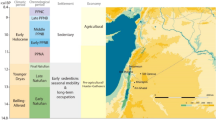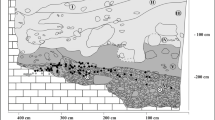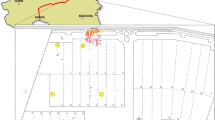Abstract
Understanding the reason(s) behind changes in human mobility strategies through space and time is a major challenge in palaeoanthropology. Most of the time this is due to the lack of suitable temporal sequences of human skeletal specimens during critical climatic or cultural shifts. Here, we present temporal variations in the Sr isotope composition of 14 human deciduous teeth and the N and C stable isotope ratios of four human remains from the Grotta Paglicci site (Apulia, southern Italy). The specimens were recovered from the Gravettian and Epigravettian layers, across the Last Glacial Maximum, and dated between 31210–33103 and 18334–19860 yr cal bp (2σ). The two groups of individuals exhibit different 87Sr/86Sr ratios and, while the Gravettians are similar to the local macro-fauna in terms of Sr isotopic signal, the Epigravettians are shifted towards higher radiogenic Sr ratios. These data, together with stable isotopes, can be explained by the adoption of different mobility strategies between the two groups, with the Gravettians exploiting logistical mobility strategies and the Epigravettians applying residential mobility.
This is a preview of subscription content, access via your institution
Access options
Access Nature and 54 other Nature Portfolio journals
Get Nature+, our best-value online-access subscription
$29.99 / 30 days
cancel any time
Subscribe to this journal
Receive 12 digital issues and online access to articles
$119.00 per year
only $9.92 per issue
Buy this article
- Purchase on Springer Link
- Instant access to full article PDF
Prices may be subject to local taxes which are calculated during checkout




Similar content being viewed by others
Data availability
All data generated or analysed during this study are included in this paper and its Supplementary Information files.
References
Kelly, R. L. Mobility/sedentism: concepts, archaeological measures, and effects. Annu. Rev. Anthropol. 21, 43–66 (1992).
Hunter, L. M. Migration and environmental hazards. Popul. Environ. 26, 273–302 (2005).
Büntgen, U. et al. 2500 years of European climate variability and human susceptibility. Science 331, 578–583 (2011).
Kelley, C. P., Mohtadi, S., Cane, M. A., Seager, R. & Kushnir, Y. Climate change in the Fertile Crescent and implications of the recent Syrian drought. Proc. Natl Acad. Sci. USA 112, 3241–3246 (2015).
Tallavaara, M., Luoto, M., Korhonen, N., Järvinen, H. & Seppä, H. Human population dynamics in Europe over the Last Glacial Maximum. Proc. Natl Acad. Sci. USA 112, 8232–8237 (2015).
Lamb, H. F. et al. 150,000-year palaeoclimate record from northern Ethiopia supports early, multiple dispersals of modern humans from Africa. Sci. Rep. 8, 1077 (2018).
Halsall, G. Barbarian Migrations and the Roman West 376–568 (Cambridge University Press, 2007).
Kuhn, S. L., Raichlen, D. A. & Clark, A. M. Y. E. What moves us? How mobility and movement are at the center of human evolution. Evol. Anthropol. 25, 86–97 (2016).
D’Andrea, W. J., Huang, Y., Fritz, S. C. & Anderson, N. J. Abrupt Holocene climate change as an important factor for human migration in west Greenland. Proc. Natl Acad. Sci. USA 108, 9765–9769 (2011).
Timmermann, A. & Friedrich, T. Late Pleistocene climate drivers of early human migration. Nature 538, 92–95 (2016).
Venkataraman, V. V., Kraft, T. S., Dominy, N. J. & Endicott, K. M. Hunter-gatherer residential mobility and the marginal value of rainforest patches. Proc. Natl Acad. Sci. USA 114, 3097–3102 (2017).
Binford, L. R. Willow smoke and dogs’ tails: hunter-gatherer settlement systems and archaeological site formation. Am. Antiq. 45, 4–20 (1980).
Pala, M. et al. Mitochondrial DNA signals of late glacial recolonization of Europe from Near Eastern refugia. Am. J. Hum. Genet. 90, 915–924 (2012).
Fu, Q. et al. The genetic history of Ice Age Europe. Nature 534, 200–205 (2016).
Arrizabalaga, A., Calvo, A., Elorrieta, I., Tapia, J. & Tarriño, A. Where to and what for? Mobility patterns and the management of lithic resources by Gravettian hunter-gatherers in the Western Pyrenees. J. Anthropol. Res. 70, 233–261 (2014).
Aranguren, B. et al. Territorial exploitation in the Tyrrhenian Gravettian Italy: the case-study of Bilancino (Tuscany). Quat. Int. 359–360, 442–451 (2015).
Moreau, L. et al. Geochemical sourcing of flint artifacts from Western Belgium and the German Rhineland: testing hypotheses on Gravettian period mobility and raw material economy. Geoarchaeology 31, 229–243 (2016).
Tomasso, A. & Porraz, G. Hunter-gatherer mobility and embedded raw-material procurement strategies in the Mediterranean Upper Paleolithic. Evol. Anthropol. 25, 164–174 (2016).
Holt, B. M. Mobility in Upper Paleolithic and Mesolithic Europe: evidence from the lower limb. Am. J. Phys. Anthropol. 122, 200–215 (2003).
Villotte, S., Samsel, M. & Sparacello, V. The paleobiology of two adult skeletons from Baousso da Torre (Bausu da Ture) (Liguria, Italy): implications for Gravettian lifestyle. C. R. Palevol. 16, 462–473 (2017).
Villotte, S., Churchill, S. E., Dutour, O. J. & Henry-Gambier, D. Subsistence activities and the sexual division of labor in the European Upper Paleolithic and Mesolithic: evidence from upper limb enthesopathies. J. Hum. Evol. 59, 35–43 (2010).
Holt, B. M. & Formicola, V. Hunters of the Ice Age: the biology of Upper Paleolithic people. Am. J. Phys. Anthropol. 137(S47), 70–99 (2008).
Boscato, P. Faunes gravettiennes à grands mammifères de l’Italie du Sud: Grotta della Cala (Salerno) et Grotta Paglicci (Foggia). Paleo 19, 109–114 (2007).
Tagliacozzo, A., Zeppieri, F., Fiore, I., Spinapolice, E. & Del Lucchese, A. Archaeozoological evidence of subsistence strategies during the Gravettian at Riparo Mochi (Balzi Rossi, Ventimiglia, Imperia – Italy). Quat. Int. 252, 142–154 (2012).
Richards, M. et al. Strontium isotope evidence of Neanderthal mobility at the site of Lakonis, Greece using laser-ablation PIMMS. J. Archaeol. Sci. 35, 1251–1256 (2008).
Willmes, M. et al. Improvement of laser ablation in situ micro-analysis to identify diagenetic alteration and measure strontium isotope ratios in fossil human teeth. J. Archaeol. Sci. 70, 102–116 (2016).
Copeland, S. R. et al. Strontium isotope evidence for landscape use by early hominins. Nature 474, 76–78 (2011).
Balter, V., Braga, J., Télouk, P. & Thackeray, J. F. Evidence for dietary change but not landscape use in South African early hominins. Nature 489, 558–560 (2012).
Lugli, F. et al. Suspected limited mobility of a Middle Pleistocene woman from southern Italy: strontium isotopes of a human deciduous tooth. Sci. Rep. 7, 8615 (2017).
Bentley, R. A. Strontium isotopes from the earth to the archaeological skeleton: a review. J. Archaeol. Method Theory 13, 135–187 (2006).
Ronchitelli, A. et al. When technology joins symbolic behaviour: the Gravettian burials at Grotta Paglicci (Rignano Garganico e Foggia e Southern Italy). Quat. Int. 359, 423–441 (2015).
Berto, C., Boscato, P., Boschin, F., Luzi, E. & Ronchitelli, A. Paleoenvironmental and paleoclimatic context during the Upper Palaeolithic (late Upper Pleistocene) in the Italian Peninsula. The small mammal record from Grotta Paglicci (Rignano Garganico, Foggia, Southern Italy). Quat. Sci. Rev. 168, 30–41 (2017).
Sommer, R. S. & Nadachowski, A. Glacial refugia of mammals in Europe: evidence from fossil records. Mammal. Rev. 36, 251–265 (2006).
Iacumin, P., Bocherens, H., Huertas, A. D., Mariotti, A. & Longinelli, A. A stable isotope study of fossil mammal remains from the Paglicci cave, Southern Italy: N and C as palaeoenvironmental indicators. Earth Planet. Sci. Lett. 148, 349–357 (1997).
Lugli, F., Cipriani, A., Peretto, C., Mazzucchelli, M. & Brunelli, D. In situ high spatial resolution 87Sr/86Sr ratio determination of two Middle Pleistocene (ca 580 ka) Stephanorhinus hundsheimensis teeth by LA–MC–ICP–MS. Int. J. Mass Spectrom. 412, 38–48 (2017).
Emery, M. V. et al. Mapping the origins of Imperial Roman workers ((1st–4th century CE) at Vagnari, Southern Italy, using 87Sr/86Sr and d18O variability. Am. J. Phys. Anthropol. 166, 837–850 (2018).
De Astis, G., Kempton, P. D., Peccerillo, A. & Wu, T. W. Trace element and isotopic variations from Mt. Vulture to Campanian volcanoes: constraints for slab detachment and mantle inflow beneath southern Italy. Contrib. Mineral Petrol 151, 331–351 (2006).
Schlüter, M., Steuber, T. & Parente, M. Chronostratigraphy of Campanian–Maastrichtian platform carbonates and rudist associations of Salento (Apulia, Italy). Cretac. Res. 29, 100–114 (2008).
Zampella, M. et al. Soil properties, strontium isotopic signatures and multi‐element profiles to authenticate the origin of vegetables from small‐scale regions: illustration with early potatoes from southern Italy. Rapid Commun. Mass Spectrom. 25, 2721–2731 (2011).
Vukosavljević, N. & Perhoč, Z. Lithic raw material procurement of the Late Epigravettian hunter-gatherers from Kopačina Cave (island of Brač, Dalmatia, Croatia). Quat. Int. 450, 164–185 (2017).
Montgomery, J., Evans, J. A. & Cooper, R. E. Resolving archaeological populations with Sr-isotope mixing models. Appl. Geochem. 22, 1502–1514 (2007).
Frei, K. M. & Price, T. D. Strontium isotopes and human mobility in prehistoric Denmark. Archaeol. Anthropol. Sci. 4, 103–114 (2012).
Binford, L. R. Dimensional analysis of behavior and site structure: learning from an Eskimo hunting stand. Am. Antiq. 43, 330–361 (1978).
Pellegrini, M. et al. Faunal migration in late-glacial central Italy: implications for human resource exploitation. Rapid Commun. Mass Spectrom. 22, 1714–1726 (2008).
Boschin, F., Boscato, P., Berto, C., Crezzini, J. & Ronchitelli, A. The palaeoecological meaning of macromammal remains from archaeological sites exemplified by the case study of Grotta Paglicci (Upper Palaeolithic, Southern Italy). Quat. Res. 90, 470–482 (2018).
Richards, M. P., Jacobi, R. M., Cook, J., Pettitt, P. B. & Stringer, C. B. Isotope evidence for the intensive use of marine foods by Late Upper Palaeolithic humans. J. Hum. Evol. 49, 390–394 (2005).
Richards, M. P. in The Evolution of Hominin Diets (eds Hublin, J. J. & Richards, M. P.) 251–257 (Springer, 2009).
Richards, M. P. & Trinkaus, E. Isotopic evidence for the diets of European Neanderthals and early modern humans. Proc. Natl Acad. Sci. USA 106, 16034–16039 (2009).
Tagliacozzo A. & Gala M. in Paglicci, l’Aurignaziano e il Gravettiano antico (ed. Di Cesnola, P.) 71–89 (Grenzi, 2004).
Mariotti Lippi, M., Foggi, B., Aranguren, B., Ronchitelli, A. & Revedin, A. Multistep food plant processing at Grotta Paglicci (Southern Italy) around 32,600 cal bp. Proc. Natl Acad. Sci. USA 112, 12075–12080 (2015).
Kelly R. L. The Foraging Spectrum: Diversity in Hunter-Gatherer Lifeways (Percheron Press, 2007).
Wall-Scheffler, C. M. & Myers, M. J. Reproductive costs for everyone: how female loads impact human mobility strategies. J. Hum. Evol. 64, 448–456 (2013).
Colonese, A. C. et al. Marine mollusc exploitation in Mediterranean prehistory: an overview. Quat. Int. 239, 86–103 (2011).
Milliken, S. Hunter‐gatherer land use in Late Glacial south‐east Italy. Oxford J. Archaeol. 17, 269–286 (1998).
Riel-Salvatore, J. & Barton, C. M. Late Pleistocene technology, economic behavior, and land-use dynamics in southern Italy. Am. Antiq. 69, 257–274 (2004).
Bentley, G. R. Hunter-gatherer energetics and fertility: a reassessment of the !Kung San. Hum. Ecol. 13, 79–107 (1985).
Andersen, K. K. et al. The Greenland ice core chronology 2005, 15–42 ka. Part 1: constructing the time scale. Quat. Sci. Rev. 25, 3246–3257 (2006).
Allen, J. R. et al. Rapid environmental changes in southern Europe during the last glacial period. Nature 400, 740–743 (1999).
Bartolomei, G., Broglio, A. & Palma di Cesnola, A. in La Fin des Temps Glaciaires en Europe (ed. de Sonneville-Bordes, D.) 297–324 (Editions du CNRS, 1979).
Borgia, V., Boschin, F. & Ronchitelli, A. Bone and antler working at Grotta Paglicci (Rignano Garganico, Foggia, Southern Italy). Quat. Int. 403, 23–39 (2016).
Brewster, C., Meiklejohn, C., von Cramon-Taubadel, N. & Pinhasi, R. Craniometric analysis of European Upper Palaeolithic and Mesolithic samples supports discontinuity at the last glacial maximum. Nat. Commun. 5, 4094 (2014).
Talamo, S. & Richards, M. A. Comparison of bone pretreatment methods for AMS dating of samples >30,000 bp. Radiocarbon 53, 443–449 (2011).
Van Klinken, G. J. Bone collagen quality indicators for palaeodietary and radiocarbon measurements. J. Archaeol. Sci. 26, 687–695 (1999).
Longin, R. New method of collagen extraction for radiocarbon dating. Nature 230, 241–242 (1971).
Ambrose, S. H. Preparation and characterization of bone and tooth collagen for isotopic analysis. J. Archaeol. Sci. 17, 431–451 (1990).
Bocherens, H. et al. Isotopic biogeochemistry (13C, 15N) of fossil vertebrate collagen: implications for the study of fossil food web including Neanderthal Man. J. Hum. Evol. 20, 481–492 (1991).
Nelson, S. J. & Ash, M. M. Wheeler’s Dental Anatomy, Physiology, and Occlusion 9th edn (Elsevier, Saunders, 2010).
Tafuri, M. A. et al. Life and death in Neolithic southeastern Italy: the strontium isotopic evidence. Int. J. Osteoarchaeol. 26, 1045–1057 (2016).
Acknowledgements
This project was funded by the European Research Council under the European Union’s Horizon 2020 Research and Innovation Programme (grant agreement No. 724046—SUCCESS, awarded to S.B.). The Radiogenic Isotope Laboratory of the University of Modena and Reggio Emilia was funded through a grant from Programma Giovani Ricercatori Rita Levi Montalcini (to A.C.). We thank Soprintendenza Archeologia, Belle Arti e Paesaggio per le Province di Barletta-Andria-Trani e Foggia for supporting researches at Grotta Paglicci, and A. Palma di Cesnola for his scientific rigour in carrying out studies at Grotta Paglicci. The authors acknowledge S. Conti for providing geological maps of the Apulia region and A. Florenzano for valuable discussions of the paleoclimate record.
Author information
Authors and Affiliations
Contributions
F.L., A.C. and S.B. conceived the study and designed the experiments. F.L. and A.C. performed the laboratory work and Sr isotope analyses. M.A.M, S.T., P.I. and M.P.R. designed and performed the stable isotope analyses. G.C., S.R., F. Boschin, P.B. and A.R. provided the samples. F. Badino, F. Boschin and P.B. reviewed palaeoclimate data. S.B., A.C. and A.R. supervised the work. All authors contributed to writing the manuscript.
Corresponding author
Ethics declarations
Competing interests
The authors declare no competing interests.
Additional information
Publisher’s note: Springer Nature remains neutral with regard to jurisdictional claims in published maps and institutional affiliations.
Supplementary information
Supplementary Information
Supplementary Figs. 1–7, Supplementary Tables 1–5, Supplementary Text and Supplementary References
Rights and permissions
About this article
Cite this article
Lugli, F., Cipriani, A., Capecchi, G. et al. Strontium and stable isotope evidence of human mobility strategies across the Last Glacial Maximum in southern Italy. Nat Ecol Evol 3, 905–911 (2019). https://doi.org/10.1038/s41559-019-0900-8
Received:
Accepted:
Published:
Issue Date:
DOI: https://doi.org/10.1038/s41559-019-0900-8
This article is cited by
-
Use of strontium isotope ratios in potential geolocation of Ajnala skeletal remains: a forensic archeological study
International Journal of Legal Medicine (2024)
-
Why the geosciences are becoming increasingly vital to the interpretation of the human evolutionary record
Nature Ecology & Evolution (2023)
-
Multiproxy bioarchaeological data reveals interplay between growth, diet and population dynamics across the transition to farming in the central Mediterranean
Scientific Reports (2023)
-
Tracing the mobility of a Late Epigravettian (~ 13 ka) male infant from Grotte di Pradis (Northeastern Italian Prealps) at high-temporal resolution
Scientific Reports (2022)
-
Monthly mobility inferred from isoscapes and laser ablation strontium isotope ratios in caprine tooth enamel
Scientific Reports (2021)



